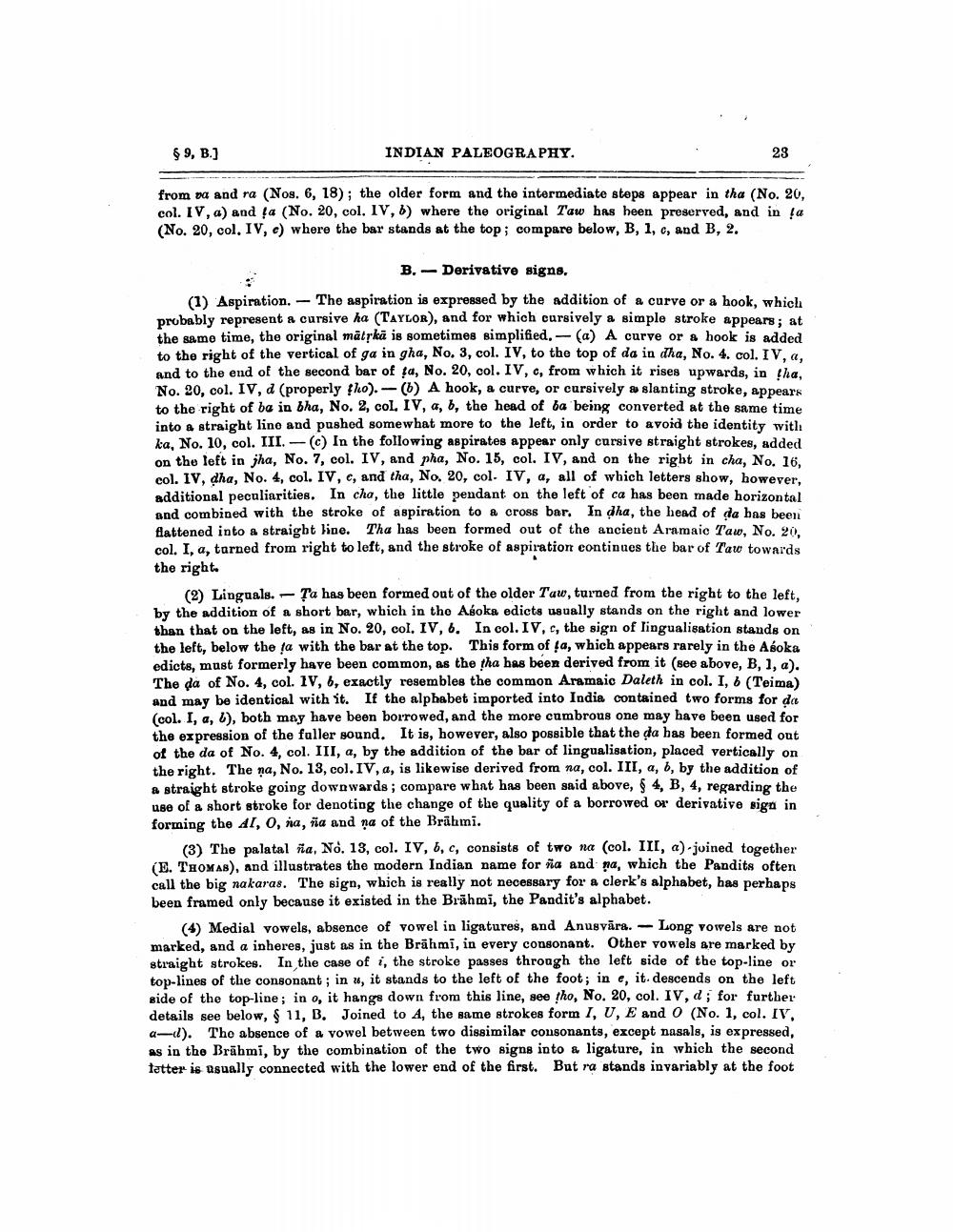________________
INDIAN PALEOGRAPHY.
§ 9, B.]
from va and ra (Nos. 6, 18); the older form and the intermediate steps appear in tha (No. 20, col. IV, a) and fa (No. 20, col. IV, 6) where the original Taw has been preserved, and in fa (No. 20, col. IV, e) where the bar stands at the top; compare below, B, 1, c, and B, 2.
23
B.
Derivative signs.
(1) Aspiration. The aspiration is expressed by the addition of a curve or a hook, which probably represent a cursive ha (TAYLOR), and for which cursively a simple stroke appears; at the same time, the original matṛkā is sometimes simplified. (a) A curve or a hook is added to the right of the vertical of ga in gha, No. 3, col. IV, to the top of da in dha, No. 4. col. IV, a, and to the end of the second bar of ta, No. 20, col. IV, c, from which it rises upwards, in tha, No. 20, col. IV, d (properly tho). (b) A hook, a curve, or cursively a slanting stroke, appears to the right of ba in bha, No. 2, col. IV, a, b, the head of ba being converted at the same time into a straight line and pushed somewhat more to the left, in order to avoid the identity with ka, No. 10, col. III. (c) In the following aspirates appear only cursive straight strokes, added on the left in jha, No. 7, col. IV, and pha, No. 15, col. IV, and on the right in cha, No. 16, col. IV, dha, No. 4, col. IV, e, and tha, No. 20, col. IV, a, all of which letters show, however, additional peculiarities. In cha, the little pendant on the left of ca has been made horizontal and combined with the stroke of aspiration to a cross bar. In dha, the head of da has been flattened into a straight line. Tha has been formed out of the ancient Aramaic Taw, No. 20, col. I, a, tarned from right to left, and the stroke of aspiration continues the bar of Taw towards the right.
(2) Linguals. Ta has been formed out of the older Taw, turned from the right to the left, by the addition of a short bar, which in the Asoka edicts usually stands on the right and lower than that on the left, as in No. 20, col. IV, 6. In col. IV, c, the sign of lingualisation stands on the left, below the fa with the bar at the top. This form of ta, which appears rarely in the Asoka edicts, must formerly have been common, as the tha has been derived from it (see above, B, 1, a). The da of No. 4, col. IV, 6, exactly resembles the common Aramaic Daleth in col. I, 6 (Teima) and may be identical with it. If the alphabet imported into India contained two forms for da (col. I, a, ¿), both may have been borrowed, and the more cumbrous one may have been used for the expression of the fuller sound. It is, however, also possible that the da has been formed out of the da of No. 4, col. III, a, by the addition of the bar of lingualisation, placed vertically on the right. The na, No. 13, col. IV, a, is likewise derived from na, col. III, a, b, by the addition of a straight stroke going downwards; compare what has been said above, § 4, B, 4, regarding the use of a short stroke for denoting the change of the quality of a borrowed or derivative sign in forming the AI, O, na, ña and na of the Brahmi.
(3) The palatal ña, No. 13, col. IV, b, c, consists of two na (col. III, a) joined together (E. THOMAS), and illustrates the modern Indian name for ña and na, which the Pandits often call the big nakaras. The sign, which is really not necessary for a clerk's alphabet, has perhaps been framed only because it existed in the Brahmi, the Pandit's alphabet.
(4) Medial vowels, absence of vowel in ligatures, and Anusvāra. Long vowels are not marked, and a inheres, just as in the Brahmi, in every consonant. Other vowels are marked by straight strokes. In the case of i, the stroke passes through the left side of the top-line or top-lines of the consonant; in u, it stands to the left of the foot; in e, it. descends on the left side of the top-line; in o, it hangs down from this line, see tho, No. 20, col. IV, d; for further details see below, § 11, B. Joined to A, the same strokes form I, U, E and 0 (No. 1, col. IV, a-d). The absence of a vowel between two dissimilar consonants, except nasals, is expressed, as in the Brahmi, by the combination of the two signs into a ligature, in which the second tetter is usually connected with the lower end of the first. But ra stands invariably at the foot




